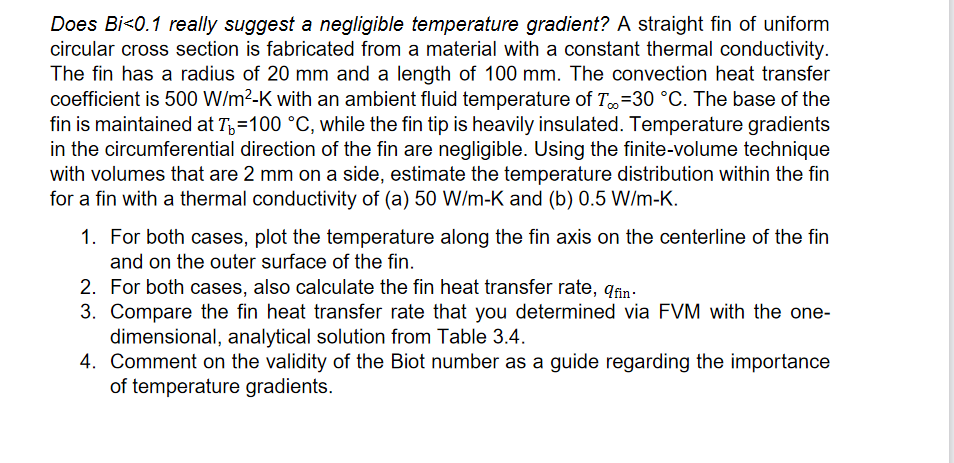Does Bi<0.1 really suggest a negligible temperature gradient? A straight fin of uniform circular cross section is fabricated from a material with a constant thermal conductivity. The fin has a radius of 20 mm and a length of 100 mm. The convection heat transfer coefficient is 500 W/m²-K with an ambient fluid temperature of T=30 °C. The base of the fin is maintained at T,=100 °C, while the fin tip is heavily insulated. Temperature gradients in the circumferential direction of the fin are negligible. Using the finite-volume technique with volumes that are 2 mm on a side, estimate the temperature distribution within the fin for a fin with a thermal conductivity of (a) 50 W/m-K and (b) 0.5 W/m-K. 1. For both cases, plot the temperature along the fin axis on the centerline of the fin and on the outer surface of the fin. 2. For both cases, also calculate the fin heat transfer rate, qin- 3. Compare the fin heat transfer rate that you determined via FVM with the one- dimensional, analytical solution from Table 3.4. 4. Comment on the validity of the Biot number as a guide regarding the importance of temperature gradients.
Does Bi<0.1 really suggest a negligible temperature gradient? A straight fin of uniform circular cross section is fabricated from a material with a constant thermal conductivity. The fin has a radius of 20 mm and a length of 100 mm. The convection heat transfer coefficient is 500 W/m²-K with an ambient fluid temperature of T=30 °C. The base of the fin is maintained at T,=100 °C, while the fin tip is heavily insulated. Temperature gradients in the circumferential direction of the fin are negligible. Using the finite-volume technique with volumes that are 2 mm on a side, estimate the temperature distribution within the fin for a fin with a thermal conductivity of (a) 50 W/m-K and (b) 0.5 W/m-K. 1. For both cases, plot the temperature along the fin axis on the centerline of the fin and on the outer surface of the fin. 2. For both cases, also calculate the fin heat transfer rate, qin- 3. Compare the fin heat transfer rate that you determined via FVM with the one- dimensional, analytical solution from Table 3.4. 4. Comment on the validity of the Biot number as a guide regarding the importance of temperature gradients.
Principles of Heat Transfer (Activate Learning with these NEW titles from Engineering!)
8th Edition
ISBN:9781305387102
Author:Kreith, Frank; Manglik, Raj M.
Publisher:Kreith, Frank; Manglik, Raj M.
Chapter8: Natural Convection
Section: Chapter Questions
Problem 8.53P
Related questions
Question
100%

Transcribed Image Text:Does Bi<0.1 really suggest a negligible temperature gradient? A straight fin of uniform
circular cross section is fabricated from a material with a constant thermal conductivity.
The fin has a radius of 20 mm and a length of 100 mm. The convection heat transfer
coefficient is 500 W/m2-K with an ambient fluid temperature of T=30 °C. The base of the
fin is maintained at T,=100 °C, while the fin tip is heavily insulated. Temperature gradients
in the circumferential direction of the fin are negligible. Using the finite-volume technique
with volumes that are 2 mm on a side, estimate the temperature distribution within the fin
for a fin with a thermal conductivity of (a) 50 W/m-K and (b) 0.5 W/m-K.
1. For both cases, plot the temperature along the fin axis on the centerline of the fin
and on the outer surface of the fin.
2. For both cases, also calculate the fin heat transfer rate, qin.
3. Compare the fin heat transfer rate that you determined via FVM with the one-
dimensional, analytical solution from Table 3.4.
4. Comment on the validity of the Biot number as a guide regarding the importance
of temperature gradients.
Expert Solution
This question has been solved!
Explore an expertly crafted, step-by-step solution for a thorough understanding of key concepts.
This is a popular solution!
Trending now
This is a popular solution!
Step by step
Solved in 2 steps with 3 images

Knowledge Booster
Learn more about
Need a deep-dive on the concept behind this application? Look no further. Learn more about this topic, mechanical-engineering and related others by exploring similar questions and additional content below.Recommended textbooks for you

Principles of Heat Transfer (Activate Learning wi…
Mechanical Engineering
ISBN:
9781305387102
Author:
Kreith, Frank; Manglik, Raj M.
Publisher:
Cengage Learning

Principles of Heat Transfer (Activate Learning wi…
Mechanical Engineering
ISBN:
9781305387102
Author:
Kreith, Frank; Manglik, Raj M.
Publisher:
Cengage Learning